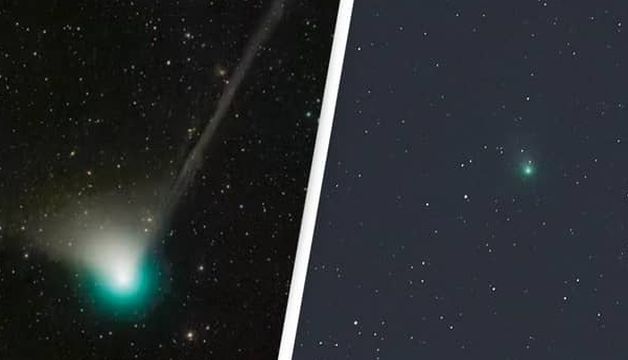Last Updated on: 13th July 2025, 08:55 am
A rare green comet called C/2022 E3 (ZTF) flies by Earth in late January and early February. Comet ZTF has not passed our planet since the last ice age, and humans may never see it again.
In fact, the “Green Comet” last visited the inner solar system 50,000 years ago, around the time Stone Age humans were thought to be beginning to develop language.
Here’s How To See A Rare Green Comet For The First Time in 50,000 Years
C/2022 E3 (ZTF) was first observed on March 10, 2022, by the Zwicky Transient Facility (ZTF) at Palomar Observatory in California, but skywatchers call it the ZTF comet for short.
It is considered an “active” comet because it releases a significant amount of gas and dust as it approaches the Sun.
Also Check, UAE Will Witness A Once in A Lifetime Sight Every 50,000 Years Next Month
There are great expectations surrounding Comet C/2022 E3 (ZTF) for several reasons:
- Perigee: On January 12th it has already made its closest approach to the Sun, known as its perihelion, while its perigee (its closest passage to Earth) will occur on February 1st. This proximity makes it a rare and exciting opportunity for scientists. Study a comet up close.
- Brightness: Some experts say C/2022 E3 (ZTF) could be visible to the naked eye, and some even say it could be one of the brightest comets in recent history. If true, it would be a spectacular sight for stargazers and stargazers.
- Timing: The comet’s close approach is expected to occur in spring and early summer in the northern hemisphere, when the weather is generally good for viewing and the comet will be visible for an extended period of time.
- Scientific interest: Comets are among the oldest bodies in the solar system, and studying them can provide insight into the formation and evolution of our solar system. Comets are also known to transport organic compounds that may have played a role in the origin of life on Earth.
This icy cosmic transient will paint a green streak across the sky through early February. You will probably need binoculars or even a telescope to spot it under dark skies far from city lights.
If you catch the ZTF comet with a telescope, you might see something like this:
The green glow is the result of the sun’s ultraviolet radiation illuminating gases escaping from the comet’s surface. There are still plenty of opportunities to catch a glimpse of ZTF, hailed as the best comet of 2023.
It can currently be observed in the early morning (pre-dawn) sky from the northern hemisphere with a telescope or binoculars. However, it may be barely visible to the naked eye by the time it reaches perigee in early February. At that time it will be about 42 million kilometers from Earth and will also be visible from the southern hemisphere.
NASA warns that comet visibility is notoriously unpredictable. According to the Royal Greenwich Observatory, London, C/2022 E3 (ZTF) should not form a visible tail without a telescope, but that too may change. At that moment, the comet appears as a fuzzy green ball in the sky.
With a stargazing app, you can find out where in the sky the comet will appear. To avoid disappointment when trying to see it in the night sky, make sure there aren’t too many clouds and make sure you’re seeing the right part of the sky from your vantage point.
According to EarthSky.org, the green space snowball will appear near Polaris (North Star) and earlier in the evening around January 30th.

Researcher, Blogger, Content Writer, Online Marketing Expert, Aptitude Test & Admissions Expert, Career Counselor.
PEC REGISTERED. ENGINEER. (NED University of Engineering & Technology)
CEO / Founder (The Educationist Hub)





